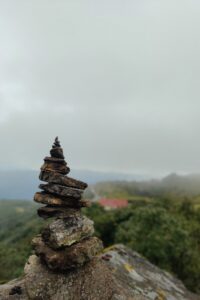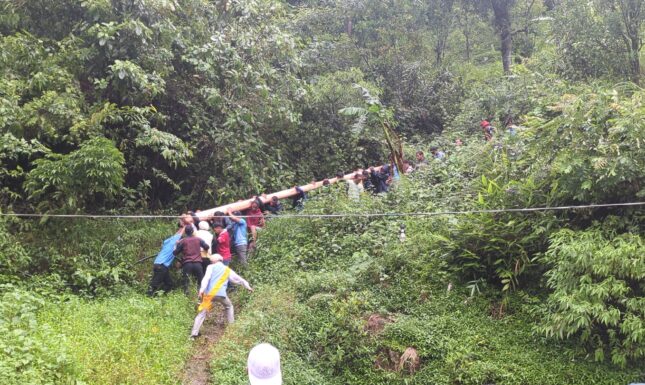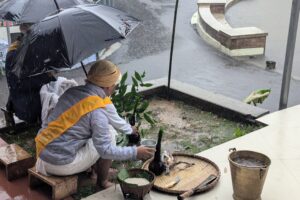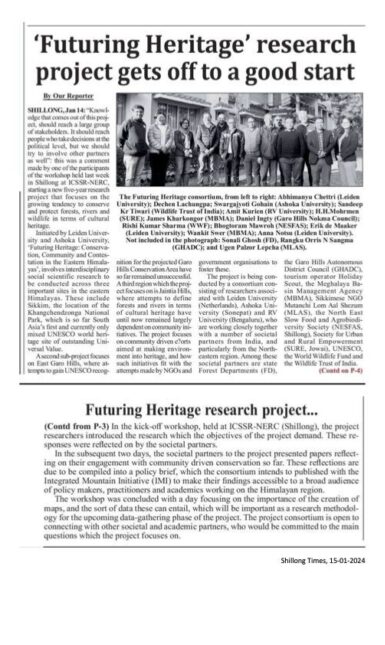
The NWO-funded project Futuring Heritage: Conservation, Community and Contestation in the Eastern Himalayas kicked off on January 6, 2025, with a multi-day workshop with our consortium members in Meghalaya, India. Abhimanyu Chettri and Anna Notsu, two PhDs of the research cohort, introduce their research projects.
January 6th, still early in the new year, marked the successful launch of our inaugural project workshop in Shillong, the Indian state of Meghalaya. The event convened our consortium of scholars, policymakers and practitioners. This project, led by PI Erik de Maaker, explores various processes of making environmental heritage, where the role of ‘community’ is key.
Our research sites in the Eastern Himalayas region of Northeast India – Sikkim, Garo Hills (Western Meghalaya) and Jaintia Hills (Eastern Meghalaya) – have witnessed a surge in conservation initiatives aimed at protecting rivers, forests and wildlife. At the kick-off meeting, however, our discussions often focused on dissension among our consortium members. What counts as a forest? What does it mean to conserve one? These differential interpretations may influence the implementation of conservation initiatives and, importantly, the trajectories of futuring.
Even when aimed at community-led conservation, what often remains unaddressed is how local inhabitants define, value and engage with their environments, now deemed needing protection. Ideas of worthiness – what is worth protecting and why – are deeply embedded in people’s everyday practices. The logic of conservation, which seeks to protect, preserve and sustain the recognised value, parallels heritage-making. In such processes, at stake is the question of what is and is not considered worthy of a future. Through Futuring Heritage, we examine diverse, at times contradictory, forms of valuing, attending to situated interpretations of spatiality and temporality that shape pathways toward the time yet to come.

Futuring ‘post-Heritage’ in Sikkim: Abhimanyu Chettri
The Indian state of Sikkim in the Eastern Himalayas is enriched by deeply entangled relationalities between its human and more-than-human residents. Home to diverse ethnic communities, flora, fauna, caves, peaks, rituals and practices, Sikkim is widely recognised as a model for sustainable development. The said understanding was furthered in 2016 when Kanchenjunga National Park, occupying a quarter of the state’s landmass, was ascribed a UNESCO mixed World Heritage site. Sikkim’s recent recognitions, while bringing visibility to previously obscured beliefs, practices and landscapes, simultaneously flatten and categorise complex everyday realities. Such an official declaration, while recognising the land as sacred, also institutionalises sacredness marginalising the other ways people experience or relate to these places. Thus, the emerging paradox between the heritagisation by UNESCO and the simplification of grounded complexities generates friction between institutionalised frameworks and the dynamic relationships that sustain the landscape.

Abhimanyu’s research in Sikkim turns a new leaf by taking the said paradox as a point of departure and exploring how these frictions among multiple ways of relating to the landscape are lived and negotiated in everyday practices. The research approaches Sikkim and the Kanchenjunga landscape as ontologically multiple, seeking to understand how different enactments in the form of heritage regimes, bureaucratic care, ritual practices, and everyday multispecies relations by its human and more-than-human residents shape the ways the landscape is inhabited, tended to and made sense of. While the recognition and environmental governance in Sikkim create new forms of legibility and authority, it’s important to interpret them as a part of the many ontological realities of the region. Through ethnographic engagement with placemaking practices and everyday engagement with the landscape, the research aims to understand how these tensions are lived, negotiated, and reworked. To answer this, Abhimanyu’s project approaches the Kanchenjunga landscape through concepts of Heritage, Landscape, and Futuring, ethnographically exploring the different ways in which multiple relationalities are stabilised, exceeded or projected into possibility.
Contested Futuring in the Jaintia Hills, Eastern Meghalaya: Anna Notsu
Unlike Sikkim, the state of Meghalaya faces worsening issues of deforestation, monocropping and resource extraction, despite its large, densely forested areas. Eastern Meghalaya – particularly the Jaintia Hills district that Anna focuses on – has long-standing associations with unregulated coal mining. In 2014, the National Green Tribunal ordered a temporary ban on such mining and export. Yet, abandoned mines and persistent mining continue to degrade the environment, polluting rivers and agricultural fields even in areas untouched by mining.

In recent years, an influx of funds from NGOs and government agencies has sought to transform these threatened landscapes. Their initiatives often centre on community-led conservation, framed simultaneously as rural development and community empowerment. Yet Meghalaya’s narrative of degradation is not straightforward: the very ‘community’ promoted as the key agent for conservation is also implicated in environmental destruction. Constitutionally protected land rights and customary law enable both destruction and recuperation.

Here, conservation is not a discrete project but a response to layered histories of land use. Crucially, what counts as ‘destruction’ is not universally agreed upon, even among local ‘communities’. This is one of the observations of Anna’s initial period of fieldwork. When a river turned orange and lifeless, interpretations varied: some saw divine anger, others an algal reaction, while many simply waited for rainfall to bring conditions back to ‘normal’. Similarly, narratives of recuperation – of which conservation is part – are entangled with relationships among those humans, deities, ancestors, other beings and institutions that continue to shape and govern notions of worthiness beyond the human realm.
With this project, Anna examines how human-environment relations complicate the very idea of a unified ‘community’. Rather than a singular collective, multiple agents – including plants, the dead, deities, spirits, ancestors – participate in processes of futuring, whether destructive, regenerative or otherwise.
Futuring Heritage
Our project, Futuring Heritage, aims to foreground how more-than-human actors negotiate what they consider worthy of attention for their futures. Through our research in Sikkim and Meghalaya, we will examine the tensions, contestations and diverse agents that shape and are shaped by the landscapes of the Eastern Himalayas. The pathways they created are not fixed, but unfolding and always situated within specific histories and contexts. From this perspective, conservation is not just about preserving the past; heritage itself questions linear categorisations of present, past and future. Through the concept of futuring, the project aims to research how multiple forms of temporalities co-exist and influence more-than-human place-making practices of the Eastern Himalayas.

This is the second of two posts on the Leiden Anthropology Blog introducing the Futuring Heritage project. The first blog post, by Erik de Maaker, has been published on September 17, 2025.






